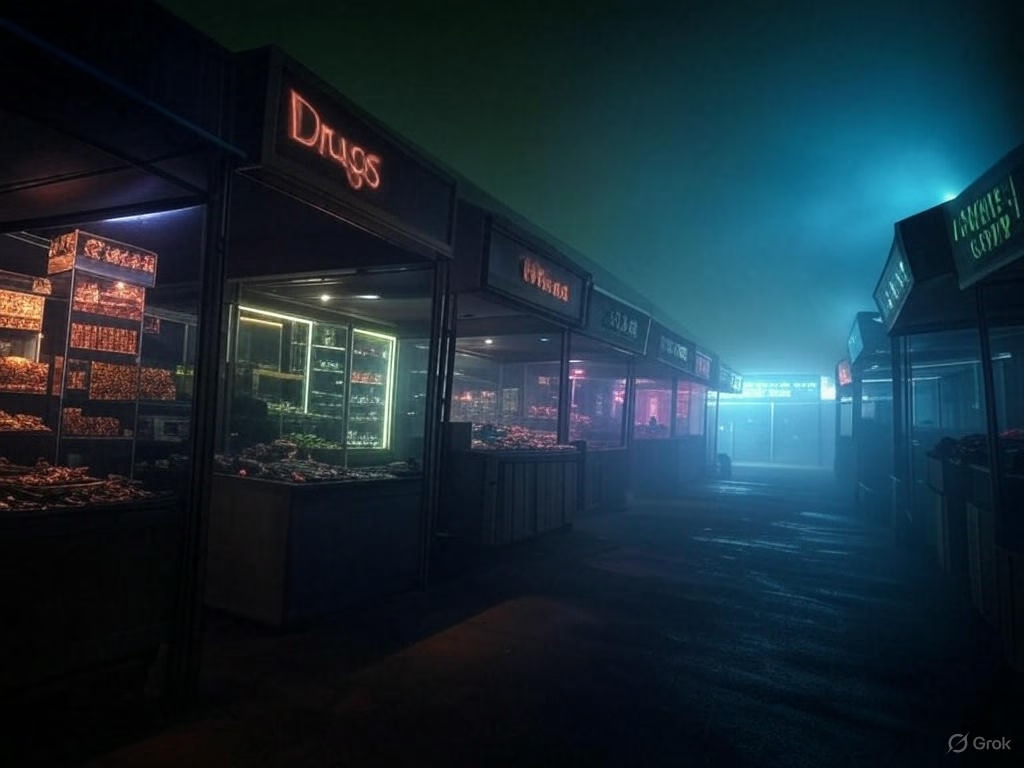Exploring the Dark Web: A Hub for Illegal Activities
The internet as we know it—Google, social media, and e-commerce sites—represents only a fraction of what exists online. Beneath this surface web lies a shadowy realm known as the dark web, a hidden network accessible only through specialized tools like Tor or I2P. While it’s often romanticized as a digital Wild West, the dark web is undeniably a hub for illegal activities, drawing cybercriminals, hackers, and illicit traders into its encrypted depths. In this post, we’ll dive into what the dark web is, why it’s a breeding ground for crime, and the kinds of activities that thrive there.
What Is the Dark Web?
The dark web is a part of the deep web—content not indexed by traditional search engines. Unlike the deep web, which includes benign private databases like academic journals or corporate intranets, the dark web is intentionally concealed. It operates on overlay networks that anonymize users through layers of encryption, making it nearly impossible to trace IP addresses or identify individuals. The most common gateway is the Tor network, which bounces traffic across multiple nodes worldwide.
This anonymity is a double-edged sword. It protects whistleblowers, activists, and journalists in oppressive regimes, but it also shields those engaging in illegal enterprises. Websites on the dark web often use .onion domains, accessible only via Tor, and transactions typically rely on cryptocurrencies like Bitcoin or Monero for untraceable payments.

Why Is the Dark Web a Hub for Illegal Activities?
The dark web’s design makes it a perfect storm for crime. Anonymity protects perpetrators, while the lack of centralized oversight means no one polices these digital back alleys. Traditional law enforcement struggles to penetrate its layers, and even when sites are shut down—like the infamous Silk Road in 2013—new ones spring up almost instantly.
Criminals exploit this environment because it offers:
- Untraceable Communication: Encrypted forums and messaging platforms allow planning without fear of interception.
- Global Reach: Buyers and sellers connect across borders, bypassing local laws.
- Cryptocurrency: Payments leave no paper trail, unlike bank transactions.
This combination creates a marketplace where anything can be bought or sold, no questions asked.
The Dark Web’s Illegal Underworld
The dark web hosts a variety of illicit activities, some more notorious than others. Here’s a closer look at what thrives in this hidden ecosystem:
- Drug Markets
Online black markets like AlphaBay (shut down in 2017) and its successors sell everything from marijuana to synthetic opioids. Vendors ship drugs disguised as everyday items, often through postal services. Buyers leave reviews, mimicking legitimate e-commerce platforms—except the products are illegal. - Weapons Trading
Firearms, ammunition, and even explosives have been found for sale. While less common than drug markets, these listings cater to those seeking untraceable weaponry, often bypassing strict national regulations. - Hacking Services
Need to breach a rival’s database or launch a DDoS attack? The dark web offers “hackers for hire,” alongside stolen data like credit card numbers, login credentials, and personal records. Data breaches often feed these markets, with information sold in bulk. - Counterfeit Money and Fake IDs
High-quality counterfeit currency, passports, and driver’s licenses are readily available. Some vendors boast advanced printing techniques, making detection difficult for the untrained eye. - Dark Pools and Extreme Content
Beyond commerce, the dark web hosts forums for extremist ideologies and illegal content. While media often exaggerates these aspects, they exist and attract those seeking unfiltered, unregulated spaces.

The Risks of Exploring the Dark Web
For the curious, venturing onto the dark web isn’t as simple as clicking a link. It requires technical know-how and carries significant risks:
- Malware: Many sites are laced with viruses or ransomware, targeting unsuspecting visitors.
- Scams: Fake vendors often take cryptocurrency and vanish, leaving buyers empty-handed.
- Legal Consequences: Accessing or participating in illegal activities can lead to prosecution, even if curiosity was the intent.
- Surveillance: Despite its anonymity, law enforcement agencies like the FBI have developed methods to track users, as seen in high-profile busts.
Law Enforcement’s Battle Against the Dark Web
Authorities worldwide are fighting back. Operations like the takedown of Silk Road and AlphaBay involved infiltrating networks, seizing servers, and arresting key figures. Cryptocurrency tracking has improved, with blockchain analysis linking transactions to real-world identities. Yet, the dark web adapts—new markets emerge, and users refine their methods to stay ahead.
The cat-and-mouse game continues, but the dark web’s resilience suggests it’s here to stay. Its existence raises tough questions: Is total anonymity a right or a threat? Can technology curb crime without infringing on privacy?
Conclusion
The dark web is a fascinating, troubling corner of the internet. It’s a hub for illegal activities, fueled by anonymity and innovation, yet it also reflects humanity’s dual nature—capable of both creation and destruction. Exploring it might satisfy curiosity, but it’s a journey fraught with danger and moral ambiguity. For most, the surface web is enough; the dark web remains a shadowy frontier best left to those who know its rules—and its risks.
What is the difference between the dark web and the deep web?
The terms “dark web” and “deep web” are often confused, but they refer to distinct parts of the internet with different characteristics. Here’s a clear breakdown of the differences:
Deep Web
- Definition: The deep web is the portion of the internet that isn’t indexed by standard search engines like Google or Bing. It includes any content that requires authentication, dynamic generation, or specific software to access.
- Scope: It’s massive—estimated to be 90-95% of the internet. Most of it is mundane and benign.
- Examples:
- Private databases (e.g., academic journals behind paywalls like JSTOR).
- Personal accounts (e.g., your email inbox, bank account portal).
- Corporate intranets or government records.
- Pages generated on-the-fly (e.g., search results on a shopping site).
- Accessibility: You don’t need special tools beyond a browser, but you might need logins, subscriptions, or specific links.
- Purpose: Primarily for privacy, security, or functionality—not inherently hidden or illegal.
Dark Web
- Definition: The dark web is a small, intentionally hidden subset of the deep web. It operates on overlay networks (like Tor or I2P) that anonymize users and require specialized software to access.
- Scope: Much smaller than the deep web, it’s a niche corner of unindexed content designed for anonymity.
- Examples:
- .onion sites hosting illegal marketplaces (e.g., drugs, weapons).
- Forums for whistleblowers or activists (e.g., SecureDrop).
- Encrypted communication platforms.
- Accessibility: Requires tools like the Tor browser or I2P, and sites often use cryptic .onion URLs (e.g., http://3g2upl4pq6kufc4m.onion).
- Purpose: Built for anonymity, which can serve both noble causes (e.g., protecting dissidents) and illicit ones (e.g., cybercrime).
Key Differences
- Size:
- Deep web: Vast, encompassing most unindexed content.
- Dark web: A tiny fraction of the deep web, deliberately concealed.
- Access:
- Deep web: Standard browsers with credentials or links.
- Dark web: Specialized software and knowledge of specific domains.
- Intent:
- Deep web: Not designed to hide; it’s just not public.
- Dark web: Engineered for anonymity and secrecy.
- Content:
- Deep web: Mostly legal, everyday data (e.g., your Netflix account).
- Dark web: Mix of legal (e.g., privacy tools) and illegal (e.g., black markets).
Analogy
Think of the internet as an ocean:
- Surface Web: The top layer—public, searchable sites like Wikipedia.
- Deep Web: The vast underwater expanse—private but not hidden (e.g., your online medical records).
- Dark Web: A submerged cave within the deep—hard to find, requiring a special key (like Tor) to enter, where some swim freely and others deal in shadows.
In short, all dark web content is part of the deep web, but not all deep web content is dark. The deep web is about inaccessibility to search engines; the dark web is about intentional obscurity and anonymity.
How Individuals Access the Dark Web
Accessing the dark web requires specific tools and steps because it’s designed to be hidden and anonymous, unlike the surface web or even most of the deep web. Here’s how people typically get in:
- Download a Specialized Browser
- Tor Browser: The most common gateway. Tor (The Onion Router) routes your internet traffic through multiple volunteer-run nodes worldwide, encrypting it at each step to mask your location and identity.
- Steps:
- Visit the official Tor Project website (torproject.org).
- Download and install the Tor Browser for your operating system (Windows, macOS, Linux, or Android).
- Launch the browser and connect to the Tor network.
- Steps:
- Alternative Tools: I2P (Invisible Internet Project) or Freenet are less popular options with similar anonymity features.
- Tor Browser: The most common gateway. Tor (The Onion Router) routes your internet traffic through multiple volunteer-run nodes worldwide, encrypting it at each step to mask your location and identity.
- Find Dark Web Sites
- Dark web sites use .onion domains, which aren’t accessible via standard browsers like Chrome or Firefox. You need Tor to resolve these addresses.
- Directories: Sites like The Hidden Wiki (a .onion site) act as starting points, listing links to other dark web pages. These can be found through surface web searches or shared in forums, but URLs change often due to shutdowns or scams.
- Search Engines: Dark web search engines like Ahmia or Torch exist, though they’re less reliable than Google and often outdated.
- Navigate and Transact
- Once connected, you can enter .onion URLs manually or follow links from directories. Sites range from forums to marketplaces.
Cryptocurrency: Transactions typically require Bitcoin, Monero, or other cryptocurrencies. You’d need a wallet (e.g., Electrum for Bitcoin) and some crypto purchased via an exchange (e.g., Coinbase) beforehand.
Precautions to Take When Accessing the Dark Web
The dark web’s anonymity cuts both ways—it hides you but also shields scammers, hackers, and law enforcement traps. Here are key precautions:
Technical Safety
- Use Tor Correctly
- Stick to the official Tor Browser. Avoid third-party versions, which could be compromised.
- Don’t maximize the browser window—Tor warns this can leak screen resolution data, potentially deanonymizing you.
- Avoid downloading files unless you trust the source; many contain malware.
- Secure Your Device
- Use a dedicated, clean device or a virtual machine (e.g., via VirtualBox) to isolate dark web activity from your main system.
- Keep your operating system and antivirus updated to guard against exploits.
- Consider a VPN before Tor for an extra layer of protection (though it’s debated—Tor alone is usually sufficient if configured right).
- Mask Your Identity
- Don’t log into personal accounts (e.g., email, social media) over Tor—it can link your real identity to your activity.
- Use a burner email or pseudonym for any registrations, and never share real personal info.
Legal and Ethical Caution
- Know the Law
- Simply accessing the dark web isn’t illegal in most places, but engaging in or purchasing illegal goods/services (e.g., drugs, stolen data) is. Curiosity is fine; crossing legal lines isn’t.
- Be aware that law enforcement monitors some sites—high-profile busts like Silk Road prove they can track users with enough effort.
- Avoid Scams
- Many dark web markets are rip-offs. Vendors may take your crypto and disappear. Stick to sites with user reviews or escrow services, though even those aren’t foolproof.
Operational Security (OpSec)
- Encrypt Communications
- Use tools like PGP (Pretty Good Privacy) for messaging. Many dark web users share public keys to verify identity and secure chats.
- Avoid unencrypted platforms or plaintext emails—they’re vulnerable to interception.
- Limit Exposure
- Don’t linger on sketchy sites. The longer you’re active, the higher the chance of encountering malware or surveillance.
- Disable JavaScript in Tor (it’s off by default in high-security mode) to block scripts that could expose you.
- Prepare for Risks
- Tape over your webcam and disable your microphone—some exploits target these.
- If you’re in a restrictive country, even using Tor might flag you to ISPs or authorities, so research local laws first.
Quick Recap
- How to Access: Install Tor Browser, connect to the network, and find .onion links via directories or searches.
- Precautions: Use secure tools, protect your identity, avoid illegal acts, and assume everything’s a potential threat.
The dark web can be explored safely with the right setup, but it’s not a casual stroll—think of it as a digital jungle where vigilance is your best defense.

What are some common illegal activities that take place on the dark web?
The dark web’s anonymity and lack of oversight make it a hotspot for illegal activities. While it’s not exclusively a criminal playground—some use it for legitimate purposes like privacy or free speech—its hidden nature attracts illicit enterprises. Here are some of the most common illegal activities that take place on the dark web:
1. Drug Trafficking
- What Happens: Online marketplaces sell everything from marijuana and cocaine to synthetic drugs like fentanyl. These operate like dark web versions of eBay, with vendors listing products, buyers leaving reviews, and escrow systems holding payments until delivery.
- Examples: Silk Road (shut down in 2013), AlphaBay (taken down in 2017), and their successors like Dream Market or White House Market.
- How It Works: Drugs are shipped discreetly—often vacuum-sealed or hidden in everyday items—via postal services. Cryptocurrencies like Bitcoin or Monero ensure untraceable payments.
- Scale: Some markets have reportedly generated millions in revenue, rivaling street-level drug trade.
2. Weapons Sales
- What Happens: Firearms, ammunition, and sometimes explosives are sold to buyers seeking untraceable weapons. This bypasses legal background checks and local restrictions.
- Examples: Handguns, rifles, or even 3D-printed gun blueprints have surfaced on dark web listings.
- How It Works: Sellers ship weapons disassembled or camouflaged (e.g., in electronics) to evade customs. Transactions use crypto, and vendors may offer tutorials on reassembly.
- Scope: Less prevalent than drugs but still a concern, especially in regions with strict gun laws.
3. Hacking and Cybercrime Services
- What Happens: Hackers offer services like DDoS attacks, ransomware deployment, or custom malware creation. Stolen data—credit card numbers, login credentials, or corporate secrets—is also sold in bulk.
- Examples: “Hacking as a service” listings or dumps of breached data from companies like Equifax or Yahoo.
- How It Works: Buyers pay for access to tools or datasets, often delivered via encrypted links or forums. Some hackers advertise “zero-day exploits” (unpatched software vulnerabilities) for high prices.
- Impact: Fuels identity theft, financial fraud, and corporate espionage.
4. Counterfeiting
- What Happens: Counterfeit money, fake IDs, passports, and driver’s licenses are produced and sold. Quality varies from amateur fakes to near-perfect replicas.
- Examples: $100 bills at a fraction of face value or passports from multiple countries.
- How It Works: Buyers order via marketplaces, and items are shipped with stealth packaging. Some vendors include UV features or holograms to mimic real documents.
- Use Case: Used for fraud, illegal immigration, or evading law enforcement.
5. Trade in Stolen Goods and Data
- What Happens: Beyond hacking services, stolen physical goods (e.g., electronics, luxury items) and digital assets (e.g., Netflix accounts, game keys) are resold.
- Examples: “Carding” sites sell cloned credit cards; others peddle hacked PayPal accounts.
- How It Works: Goods are fenced through dark web forums or markets, often sourced from theft or phishing scams. Payments are crypto-based.
- Volume: A steady trade, feeding off surface web breaches and physical crime.
6. Illegal Content Distribution
- What Happens: The dark web hosts sites sharing extreme or banned material, including pirated media, explicit content, or extremist propaganda.
- Examples: Forums distributing hacked movies, restricted books, or manuals for illegal activities (e.g., bomb-making guides).
- How It Works: Content is uploaded to .onion sites or shared via peer-to-peer networks like I2P. Access might require invites or payments.
- Controversy: While piracy is common, the darkest corners—often exaggerated in media—deal in more disturbing material, drawing law enforcement scrutiny.
7. Money Laundering
- What Happens: Cryptocurrency tumbling or mixing services obscure the origin of funds, helping criminals clean dirty money.
- Examples: Services that take your Bitcoin, mix it with others, and return “clean” coins for a fee.
- How It Works: Users send crypto to a service, which pools and redistributes it, breaking the blockchain trail. Some markets offer this built-in.
- Significance: Ties into other dark web crimes, making profits harder to trace.
Why These Thrive
- Anonymity: Tor and similar networks hide user identities.
- Cryptocurrency: Untraceable payments fuel transactions.
- Lack of Regulation: No central authority polices the space.
- Global Reach: Connects buyers and sellers worldwide, dodging local laws.
Law Enforcement Response
Authorities have shut down major hubs (e.g., Silk Road,

What measures are being taken to combat the proliferation of illegal activities on the dark web?
Combating the proliferation of illegal activities on the dark web is a complex challenge that involves a mix of technological, legal, and collaborative efforts by law enforcement, governments, private organizations, and international bodies. Here’s an overview of the key measures being taken:
1. Law Enforcement Operations and Takedowns
- Marketplace Shutdowns: Agencies like the FBI, DEA, Europol, and Interpol have targeted major dark web marketplaces. High-profile examples include the takedowns of Silk Road (2013), AlphaBay (2017), and Hansa (2017). These operations often involve undercover agents infiltrating sites, seizing servers, and arresting key operators.
- Coordinated Stings: Multi-agency efforts, such as Operation Onymous (2014) and Operation Hyperion, have led to the closure of numerous sites and the arrest of vendors selling drugs, weapons, and stolen data. In 2018, a U.S.-led undercover operation resulted in over 35 arrests and the seizure of $23.6 million in illicit goods.
- Focus on Cryptocurrency Tracking: Law enforcement has improved blockchain analysis to trace cryptocurrency transactions (e.g., Bitcoin, Monero), which are central to dark web commerce. Companies like Chainalysis assist in linking wallet addresses to real-world identities.
2. Technological Tools and Intelligence Gathering
- Dark Web Monitoring: Agencies use specialized software to scrape .onion sites, monitor forums, and track illegal activities. Tools like Memex (developed by DARPA) help search unindexed content and identify patterns.
- Cyber Threat Intelligence: Security firms and researchers analyze dark web chatter to preempt crimes, such as data dumps or planned cyberattacks. This intel is shared with law enforcement to disrupt operations early.
- Deanonymization Techniques: Despite Tor’s encryption, agencies exploit vulnerabilities—like poor operational security (OpSec) by users—or use traffic correlation attacks to identify individuals. The Silk Road bust, for instance, partly relied on Ross Ulbricht’s digital slip-ups.
3. Legislative and Policy Measures
- Stricter Laws: Countries have updated cybercrime laws to address dark web activities. In the U.S., the Computer Fraud and Abuse Act and RICO statutes are used to prosecute dark web operators. The EU’s Cybercrime Directive enhances penalties and cooperation.
- Cryptocurrency Regulation: Governments are cracking down on unregulated crypto exchanges and mixers (tumblers) that launder dark web profits. The U.S. Treasury’s FinCEN has targeted services like Helix and Bitcoin Fog.
- Censorship Efforts: Authoritarian regimes like China and Russia block Tor relays or outlaw anonymity tools entirely, though this often aims to suppress dissent rather than just crime.
4. International Collaboration
- Joint Task Forces: The Joint Criminal Opioid and Darknet Enforcement (JCODE) team, launched by the U.S. Department of Justice in 2018, coordinates global efforts against opioid trafficking on the dark web. Interpol’s Darknet and Cryptocurrency Working Group fosters cross-border intelligence sharing.
- Operation Examples: In 2019, Interpol and the EU led a sting across 19 countries, shutting down 50 sites and arresting 247 suspects. Such operations highlight the need for global cooperation given the dark web’s borderless nature.
5. Private Sector Involvement
- Cybersecurity Firms: Companies like CrowdStrike, Rapid7, and SpyCloud monitor dark web markets for stolen data, alerting businesses and individuals to breaches. They provide actionable intelligence to prevent downstream crimes like identity theft.
- Tech Partnerships: Browser developers and ISPs sometimes assist by flagging suspicious traffic, though this raises privacy debates. Tor itself, while privacy-focused, cooperates with law enforcement when legally compelled.
6. Education and Prevention
- Public Awareness: Governments and organizations run campaigns to warn users about dark web risks, such as scams or legal consequences. The UK’s National Crime Agency, for example, educates youth about online exploitation.
- Business Protections: Companies are encouraged to adopt dark web monitoring, strong cybersecurity (e.g., two-factor authentication), and employee training to reduce vulnerabilities that feed dark web markets (e.g., data breaches).
7. Targeting User Behavior
- Undercover Buyers: Law enforcement poses as buyers to identify and arrest vendors. This tactic was key in dismantling AlphaBay, where agents took over the site to gather evidence.
- Psychological Insights: Research into criminal motivations (e.g., thrill-seeking, profit) helps design interventions, though this is still emerging. Promoting “pro-social” online behavior is a long-term goal.
Challenges and Adaptations
- Resilience: When one market falls, others (like Dream Market or Wall Street Market) rise. Criminals adapt with better OpSec, decentralized platforms, or privacy coins like Monero.
- Resource Gaps: Many agencies lack the training or tools to keep pace, especially at local levels. The dark web’s rapid evolution outstrips some enforcement capabilities.
- Ethical Tension: Balancing privacy rights (e.g., Tor’s legitimate uses) with crime prevention remains contentious. Overreach risks alienating users or driving criminals deeper underground.
Current Trends (as of March 20, 2025)
- Law enforcement is increasingly focusing on fentanyl sales, a major dark web driver, with JCODE reporting hundreds of arrests annually. Advances in AI-driven monitoring and quantum computing may soon enhance tracking, though criminals are likely countering with AI of their own.
In summary, combating dark web crime involves aggressive policing, cutting-edge tech, global teamwork, and preventive education. While successes like marketplace busts show progress, the dark web’s adaptability ensures this remains an ongoing battle.
Cybercrime and Fraud Schemes

Let’s dive deeper into cybercrime and fraud schemes on the dark web, a major category of illegal activity that thrives in its anonymous, unregulated corners. This section will explore the types of cybercrimes and fraud schemes, how they’re executed, their scale, specific examples, and the measures being taken to combat them as of March 20, 2025.
Types of Cybercrime and Fraud Schemes on the Dark Web
- Data Trafficking (Stolen Data Sales)
- What It Is: Hackers sell datasets stolen from breaches—credit card numbers, bank details, Social Security numbers, login credentials, medical records, or corporate secrets.
- Execution: Data is harvested via phishing, malware (e.g., keyloggers), or exploits targeting companies. It’s then packaged into “dumps” and sold on dark web marketplaces or forums.
- Scale: A single breach can yield millions of records. For example, the 2021 T-Mobile breach exposed 47 million records, many of which likely hit dark web markets.
- Pricing: Credit card details with CVV codes might go for $5-$20 each, while full identities (“fullz”) fetch $50-$100, depending on freshness and country.
- Hacking Services for Hire
- What It Is: “Hackers as a service” offer tailored attacks—DDoS floods, ransomware deployment, or website defacement—for a fee.
- Execution: Buyers specify targets (e.g., a competitor’s site), and hackers deliver, often providing proof like screenshots or stolen files. Listings advertise expertise levels, from script kiddies to elite coders.
- Scale: Smaller attacks might cost $100-$500, while sophisticated jobs (e.g., zero-day exploits) can run into thousands or more.
- Examples: The “Lizard Squad” group, once active on dark web forums, rented out DDoS tools before pivoting to surface web infamy.
- Carding and Financial Fraud
- What It Is: “Carding” involves using stolen credit card details to buy goods, gift cards, or crypto, often resold for profit.
- Execution: Cards are tested for validity on dark web “carding shops,” then used via VPNs or proxies to mask locations. “Cash-out” services convert digital gains into physical cash or goods.
- Scale: A 2023 Europol report estimated carding losses at €1 billion annually across Europe alone.
- Tools: Sites sell “skimmers” (devices to steal card data from ATMs) and tutorials on bypassing anti-fraud systems.
- Ransomware and Extortion
- What It Is: Ransomware groups encrypt victim data and demand payment, often brokered or advertised on the dark web. Extortion adds threats to leak stolen data.
- Execution: Malware is spread via phishing or exploited vulnerabilities (e.g., unpatched software). Dark web sites host payment portals or leak stolen files if ransoms aren’t paid.
- Scale: The 2021 Colonial Pipeline attack (linked to DarkSide, a dark web group) cost $4.4 million in ransom. Global losses hit $20 billion in 2023, per Cybersecurity Ventures.
- Examples: REvil and Conti operated dark web leak sites, showcasing stolen data to pressure victims.
- Counterfeit Money and Fake Documents
- What It Is: High-quality counterfeit currency, IDs, passports, or diplomas are produced and sold for fraud or evasion.
- Execution: Vendors use advanced printers and materials (e.g., UV ink, microtext) to mimic originals. Orders are placed on marketplaces, shipped discreetly, and paid in crypto.
- Scale: A 2022 Interpol bust seized $11 million in counterfeit euros linked to dark web sales.
- Examples: Listings for $10,000 in fake USD might cost $1,000 in Bitcoin, with “pass rates” (likelihood of fooling banks) advertised.
- Phishing Kits and Malware Sales
- What It Is: Ready-made tools—phishing pages, trojans, or botnets—are sold to less-skilled criminals for launching their own scams.
- Execution: Kits mimic legit sites (e.g., PayPal login pages) to steal credentials. Buyers deploy them via email or SMS campaigns, with profits split or sold outright.
- Scale: A single kit can cost $50-$200 and enable thousands of attacks. Dark web forums like Exploit.in have long been hubs for such trades.
- Examples: The “Kraken” malware kit, sold for $1,000, targeted banks in 2024, per recent X posts from cybersecurity analysts.
How These Schemes Operate
- Marketplaces: Platforms like Dread, Dark0de, or successors to AlphaBay host listings with escrow systems, reviews, and vendor ratings, mimicking e-commerce but for crime.
- Anonymity Tools: Tor, I2P, and VPNs hide identities. Encrypted chats (e.g., Jabber, Wickr) coordinate deals.
- Payment: Bitcoin dominates, but privacy coins like Monero (harder to trace) are gaining traction. Tumblers mix funds to obscure origins.
- OpSec: Savvy criminals use burner devices, fake identities, and multi-step laundering to avoid detection.
Real-World Impact
- Individuals: Identity theft from stolen “fullz” can ruin credit or drain accounts. A 2023 victim lost $80,000 after dark web-sold data fueled a bank scam.
- Businesses: Ransomware cripples operations—hospitals, schools, and firms like Garmin (2020) have paid millions.
- Economy: Carding and counterfeiting erode trust in financial systems, with global fraud losses projected at $43 billion by 2025 (Statista).
Measures to Combat Cybercrime and Fraud on the Dark Web
- Law Enforcement Efforts
- Infiltration: Undercover agents pose as buyers or vendors to gather evidence. The AlphaBay takedown relied on Dutch police running the site covertly for weeks.
- Seizures: Servers hosting markets or data are confiscated—e.g., the 2021 RaidForums bust seized 10TB of stolen data.
- Arrests: Key figures like Alexandre Cazes (AlphaBay founder) are targeted, often via OpSec errors like reusing emails.
- Blockchain Analysis
- Tools: Firms like Chainalysis, Elliptic, and CipherTrace track crypto flows, linking dark web wallets to exchanges where users cash out. A 2024 Chainalysis report traced $1.7 billion in illicit Bitcoin.
- Success: The 2022 arrest of a ransomware operator came after Monero transactions were unraveled via exchange KYC data.
- Cybersecurity Countermeasures
- Threat Intel: Companies like Recorded Future scrape dark web forums, alerting clients to leaked credentials or planned attacks. A 2025 X post from @DarkWebInformer flagged a new carding dump hours after it surfaced.
- Honeypots: Fake sites or servers lure hackers, exposing their methods. The FBI has used this to trace phishing kit buyers.
- Patching: Firms push rapid updates to vulnerabilities (e.g., Log4j in 2021) exploited for ransomware.
- Financial Crackdowns
- Mixer Shutdowns: Services like Tornado Cash faced U.S. sanctions in 2022, disrupting laundering pipelines. A 2024 Europol sting hit 12 tumblers.
- Exchange Compliance: Platforms like Binance now enforce stricter KYC, cutting off dark web cash-out routes.
- International Operations
- Europol’s EC3: The European Cybercrime Centre coordinates cross-border busts, like the 2023 dismantling of a carding ring spanning 15 countries.
- Five Eyes: U.S., UK, Canada, Australia, and New Zealand share dark web intel, targeting ransomware groups like LockBit.
- AI and Automation
- Detection: AI scans dark web traffic for patterns—e.g., IBM’s X-Force flagged a 2024 phishing kit surge. Law enforcement trials AI to predict market resurgences.
- Criminal Pushback: Hackers counter with AI-generated phishing or obfuscated code, escalating the tech arms race.
Challenges
- Adaptability: Post-takedown, markets like Hydra (busted 2022) spawn clones within weeks. Decentralized platforms (e.g., OpenBazaar) resist shutdowns.
- Volume: Millions of daily transactions overwhelm manual tracking—automation lags behind.
- Jurisdiction: Operators in uncooperative nations (e.g., Russia-linked REvil) evade extradition.
Current State (March 20, 2025)
Recent X posts from @CyberSecNews highlight a 2025 surge in ransomware-as-a-service (RaaS), with groups like BlackCat offering affiliates 80% of profits. Law enforcement scored a win in February 2025, seizing a .onion site with 1.2 million stolen cards, per an FBI press release. Yet, the dark web’s cybercrime ecosystem remains robust, fueled by breaches and crypto anonymity.
This deep dive shows how cybercrime and fraud schemes exploit the dark web’s shadows—and the multifaceted fight to curb them.
You may like this Article Child exploitation online! How protect

